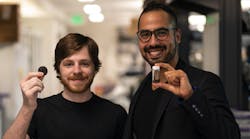NASA is sending biomaterial samples from Johns Hopkins University to the International Space Station, where their ability to protect against harmful radiation will be put to the test.
The samples consist of fungus-grown melanin and polymers biomaterials that Johns Hopkins researcher Radamés J.B. Cordero has spent the past four years developing and studying. On the space station, the material will be checked for its ability to protect against space radiation. Test results could lead to new ideas on how to protect humans from harmful radiation in outer space and on Earth.
Melanin, a dark brown or black pigment, absorbs harmful ionizing radiation that damages cells, and is found across all biological kingdoms. After isolating a powdered form of melanin from the fungus, scientists embedded it in plastic polymers. The resulting material will also be tested for its structural stability and its ability to withstand the environment of outer space.
“We know that space radiation is dangerous and that it damages matter,” says Cordero. “Radiation is hazardous to astronauts and equipment in space, but radiation exposure is also a concern of healthcare providers and patients during radiation imaging, radiation therapy, and similar procedures. If you have a material that shields against radiation, it could protect astronauts and structures in space but also benefit people here on Earth.”
This is the first time melanin has been sent to space for testing, partly because the it is extremely expensive to produce—about $400 per gram. Cordero’s works with a form of melanin grown in the fungus Cryptococcus neoformans. And there are two good reasons for that.
“When we looked at studies of melanin in the fungal kingdom, we found that melanin not only protects against UV but also protects against other types of ionizing radiation,” Cordero explains.
Researchers also expect it the fungus will be a more cost-effective “biofactory” for melanin and lower its cost. This could open the door to melanin being used for other medically protective purposes.
After isolating a powdered form of melanin from the fungus, it was embedded in plastic polymers. The resulting material will also be tested for its structural stability and its ability to withstand the environment of outer space.
The study take at least several months, and Cordero expects to receive experimental data from the ISS beginning in the middle of next year. He has two additional NASA studies that will take shape over the coming months, with the next study scheduled to launch to the ISS sometime next year.
He says he never expected that his work on microscopic materials would end up traveling to outer space.
“It was a big surprise to be able to do this research, and I wish there was a camera outside the space station looking at the melanin 24/7 so I could watch,” Cordero says with a laugh.

